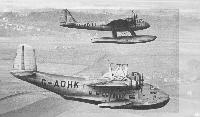Фотографии
-
Регистрационный номер: 8103 Salt in the slipstream - while with Prodger-lsaac, Lankester Parker was able to use his experience of seaplane-flying at Lake Windermere to test-fly Short Type 184s from Eastchurch. This glorious photograph shows Short 184 serial 8103 on the Medway in 1915.
Самолёты на фотографии: Short Type 184/225/827/830/310/320 - Великобритания - 1914
-
Регистрационный номер: G-ADHK [2] John Lankester Parker (furthest right) with Capt A.S. Wilcockson (centre) and Harold Piper, his colleagues during the trials of the Short Mayo Composite at Rochester in 1938. We have used Merriam’s own original title for Lankester Parker’s chapter - “Better To Be Born Lucky Than Rich” - luck always trumps money in the test-flying business!
Самолёты на фотографии: Short Mayo Composite (S.20 Mercury and S.21 Maia) - Великобритания - 1938
-
Регистрационный номер: G-ADHJ, G-ADHK [2] 6-8 октября 1938г.: Short S.20 Mercury, пилотируемый капитаном Д. Беннеттом, участвовал в попытке установления нового рекорда дальности для гидропланов. Взлетев с авиаматки S.21 Maia к северу от Данди, Mercury приземлился в Порт-Ноллоте (Южная Африка), преодолев без посадки 9651,90 км за 41 ч 56 мин.
On February 23, 1938, Lankester Parker was at the controls of Maia, the lower component of the Short Mayo Composite, for the second successful separation of the “pickaback” aircraft. Harold Piper was flying the upper component, Mercury. The idea showed some promise but the outbreak of war stymied its development.Самолёты на фотографии: Short Mayo Composite (S.20 Mercury and S.21 Maia) - Великобритания - 1938
-
Frederick Warren Merriam comes in to land at Hendon in a Maurice Farman Longhorn. Merriam was the chief instructor of the Bristol Flying School at Brooklands until he was appointed civilian instructor to the Naval Flying School at Hendon in September 1914, despite having volunteered for active service when war broke out.
Самолёты на фотографии: Maurice Farman MF.7 Longhorn - Франция - 1912
-
During 1916-18 Lankester Parker was a test pilot for the London-based Prodger-lsaac Aviation Co. Here Clifford Prodger (left) and Bernard Isaac pose beside a Handley Page O/400 bomber circa 1918.
Самолёты на фотографии: Handley Page H.P.12 (O/400) - Великобритания - 1917
-
Регистрационный номер: VT-AGU The shapely nose of the first Short Scion Senior. This machine has been sold to the Irrawaddy Flotilla Company for work in the east. Standing on one of the floats is Mr. J. Lankester Parker, Short's chief test pilot.
A splendid photograph of John Lankester Parker standing on the port float of the first Short Scion Senior, VT-AGU, moored in the Medway before its delivery to the Irrawaddy Flotilla Co in Rangoon in January 1936. Lankester Parker flew every Short prototype on its maiden flight until his retirement from test flying in 1945.Самолёты на фотографии: Short Scion Senior / S.22 - Великобритания - 1935
-
An early example of the aviation photographer’s abiding love of juxtaposing the biggest and smallest aircraft of the day, this photograph shows Eastchurch-built Short Bomber serial 9340 (right) alongside the tiny P. V.8 Eastchurch Kitten. This Short Bomber was one of many Lankester Parker flew for their Navy acceptance trials.
Самолёты на фотографии: Port Victoria P.V.8 Eastchurch Kitten - Великобритания - 1917Short Bomber / Type 224 - Великобритания - 1915
-
The Short S.538, nicknamed Shamrock, was a development of the Shirl torpedo-bomber, and was built specially for an attempt on the first non-stop transatlantic flight. It suffered engine failure on its way to Ireland in April 1919, however, and by the time it had been repaired Alcock and Brown had made their historic Vickers Vimy flight that June.
Самолёты на фотографии: Short Shirl - Великобритания - 1918
-
Lankester Parker in the rear seat of the Silver Streak, Short’s first venture into aircraft construction using Duralumin, an aluminium alloy first used in the construction of German airships, and later by Hugo Junkers for aircraft. Lankester Parker made the first flight of the Silver Streak, Britain’s first all-metal aircraft, in August 1920.
Самолёты на фотографии: Short Silver Streak - Великобритания - 1920
-
Another of Lankester Parker’s early inspirations was Frederick Phillips Raynham, who is seen here beside his Avro 500 at Hendon in the late summer of 1913. Raynham was only 17 years old when he gained his RAeC Aviator’s Certificate (No 85) in 1911.
Самолёты на фотографии: Avro Type E / 500 - Великобритания - 1912
Статьи
- -
- ??? - David Lockspeiser: 1927-2014
- A.Steenbeck - Lowengeschwader's Big Bang
- B.Dunnell - Flying the Pucara
- D.Gordon - Exercise Shiksha: sharpening India's cold war claws
- F.Merriam - "Better to be Born Lucky than Rich..." /Echoes from Dawn Skies/ (3)
- K.Brookes - Merlin Magic at Farnborough
- M.Goodall - Pemberton Billing an the Four-Winged Farrago
- N.Helmo-Larsen - Who needs a pilot?
- P.Davidson - Off the Beaten Track...
- P.Jarrett - Lost & Found
- P.Jarrett - The Ugly Thuth?
- R.Mulder - Capital Gains: Oslo-Fornebu airport 1934-40
- R.Riding - The Aeroplane that Flies Itself
- R.Tisdale, A.Vercamer - Before & After
- W.Thompson - Distant Thunder









